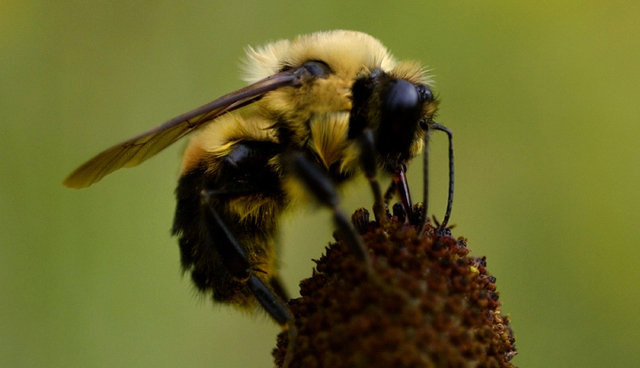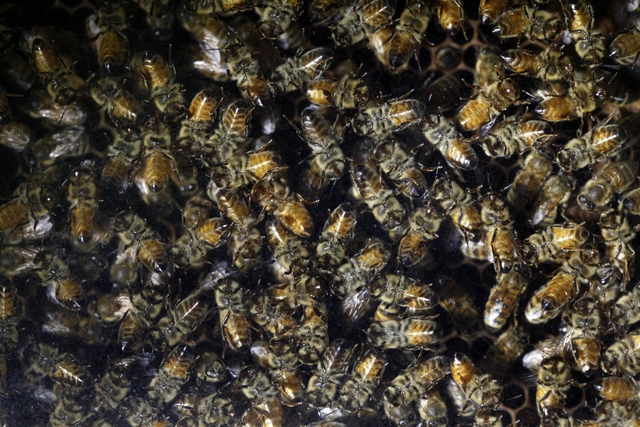WASHINGTON — A common type of pesticide is dramatically harming wild bees, according to a new in-the-field study that outside experts say may help shift the way the U.S. government looks at a controversial class of chemicals. ADVERTISING WASHINGTON —
WASHINGTON — A common type of pesticide is dramatically harming wild bees, according to a new in-the-field study that outside experts say may help shift the way the U.S. government looks at a controversial class of chemicals.
But in the study published by the journal Nature on Wednesday, honeybees — which get trucked from place to place to pollinate major crops like almonds— didn’t show the significant ill effects that wild cousins like bumblebees did. This is a finding some experts found surprising. A second study published in the same journal showed that in lab tests bees are not repelled by the pesticides and in fact may even prefer pesticide coated crops, making the problem worse.
Bees of all kinds — crucial to pollinating plants, including major agricultural crops — have been in decline for several reasons. Pesticide problems are just one of many problems facing pollinators; this is separate from colony collapse disorder, which devastated honeybee populations in recent years but is now abating, experts said.
Exposure to neonicotinoid insecticides reduced the density of wild bees, resulted in less reproduction, and colonies that didn’t grow when compared to bees not exposed to the pesticide, the study found.
Scientists in Sweden were able to conduct a study that was in the wild, but still had the in-the-lab qualities of having control groups that researchers covet. They used 16 patches of landscape, eight where canola seeds were coated with the pesticide and eight where they weren’t, and compared the two areas.
When the first results came in, “I was quite, ‘Oh my God,’” said study lead author Maj Rundlof of Lund University. She said the reduction in bee health was “much more dramatic than I ever expected.”
In areas treated with the pesticide, there were half as many wild bees per square meter than there were in areas not treated, Rundlof said. In the pesticide patches, bumblebee colonies had “almost no weight gain” compared to the normal colonies that gained about a pound, she said.
University of Illinois entomologist May Berenbaum, who wasn’t part of either study and last year was awarded the National Medal of Science, said in an email that the studies “indicate that, at least with current technology, systemic use of pesticides is fraught with environmental problems.”
The European Union has a moratorium on the use of neonicotinoids and some environmentalists are pushing for the same in the United States. Rundlof conducted her study just before the European ban went into effect in 2013.
“This paper has the potential of really shifting the conversation,” said University of Maryland entomologist Dennis vanEnglesdorp, who wasn’t part of the study. “Neonics may have a very dramatic effect on these non-managed pollinators in the environment. This is the most definitive work I’ve seen in the area.”
One of the more interesting aspects of Rundolf’s study is that she couldn’t measure an effect on honeybees, just wild native bees. There may be an effect but it would be under 20 percent, she said. The different species of bees respond differently and that only results in confusion because until now, scientists have used the domesticated honeybees as the model for all bees.
Scientists speculated why there is a difference. It could be that honeybees, which have colonies in the tens of thousands, can absorb more losses than the more solitary native bees, which have smaller colonies and have more difficulty getting new queens, Rundlof said.
It could be that because honeybees are more social, “they are probably much better adapted at taking abuse,” said vanEnglesdorp.
While many large farms rely on honeybee colonies, a 2013 study found that wild bees and other insects were more important in pollination than previously thought and far more efficient at pollination than honeybees. Plus, the wild flowers around the world are mostly pollinated by wild bees, said Rundolf’s co-author, Henrik Smith of Lund University.
David Fischer, director of pollinator safety for neonicotinoid manufacturer Bayer CropScience, emphasized the lack of harm found in honeybees, saying “that’s the part of the story that seems to be not being paid attention to.” He said this should be reassuring for beekeepers.
Fischer faulted the Rundlof study for using unrealistically large amounts of the pesticide — 2.5 times what is applied in the United States. He called it “an overdose.” But Rundlof said she used dosages recommended in Bayer CropScience documents that she provided.
Bee scientist Jeff Pettis of the U.S. Department of Agriculture said the Rundlof study finds the pesticide is a real problem for wild bees and “it does it under real world, well-replicated conditions” while using realistic doses.
Environmental activist groups are using the study to step up pressure on the U.S. government to ban the pesticide class. Lori Ann Burd, environmental health director at the Center for Biological Diversity, said federal agencies “must step up and take action to ban these dangerous chemicals before it is too late to save our wild bees.”




